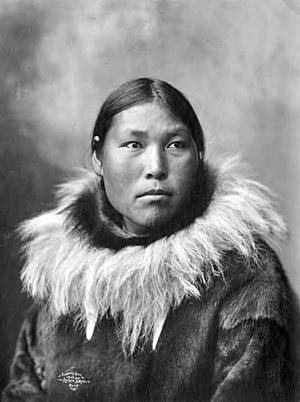Tavlugun facts for kids
The tavluġun is a special type of tattoo worn by Iñupiaq women. The Iñupiat are an indigenous group from Alaska and parts of Canada. These tattoos are usually found on the chin and have been an important part of Iñupiaq culture for hundreds of years. They are much more than just designs; they tell stories about a woman's life and her connection to her community.
Contents
Tavluġun: Iñupiaq Chin Tattoos
The word tavluġun itself refers to these unique chin tattoos. For Iñupiaq women, getting a tavluġun was a significant event. It showed their identity and their place within their community. These tattoos were a way to honor their heritage and connect with their ancestors.
Why are Tavluġun Important?
Tavluġun tattoos held deep meaning for Iñupiaq women. They were often a sign of reaching adulthood. A young woman might receive her first tattoo when she was ready to marry or after she had her first period. This marked her transition from a girl to a woman.
Cultural Significance
These tattoos also showed a woman's skills and achievements. For example, a woman who was good at hunting or sewing might get a special tattoo. The designs could also represent her family, her village, or important events in her life. They were a visible way to carry her personal and cultural history.
Spiritual Connection
Some Iñupiaq people believed that tavluġun tattoos had spiritual power. They might protect a woman or connect her to the spirit world. The patterns were not just pretty; they were symbols with deep spiritual importance.
How Were Tavluġun Made?
The traditional way to create tavluġun was quite different from modern tattooing. It involved a method called skin-stitching or poke-and-tap.
Skin-Stitching Method
In the skin-stitching method, a needle made of bone or ivory was used. This needle was threaded with a sinew (a strong fiber from an animal tendon) that had been coated in soot. The soot came from lamps that burned seal oil. The artist would then pull the soot-covered thread just under the skin. This left a line of dark pigment.
Poke-and-Tap Method
The poke-and-tap method involved using a sharp tool, like a bone needle. The artist would dip the needle in soot and then gently tap it into the skin. This created a series of small dots that formed a line or pattern. Both methods were done with great care and skill.
Tavluġun Today
For many years, the practice of getting tavluġun tattoos almost disappeared. This happened because of outside influences and changes in Iñupiaq culture. However, in recent times, there has been a strong revival of this beautiful tradition.
Revival of the Tradition
Today, many young Iñupiaq women are choosing to get tavluġun tattoos. They do this to honor their ancestors and to reclaim their cultural identity. It is a powerful way for them to show pride in who they are and where they come from. The revival of tavluġun is a sign of strength and resilience within the Iñupiaq community.
See also
- Kakiniit
- Yidįįłtoo, the traditional face tattoos of the Hän Gwich’in.


